 |
Peter Masters |
Peter Masters |
|
|
|||||
| About me | About this site | My books | |||||||
Practical Wax Play
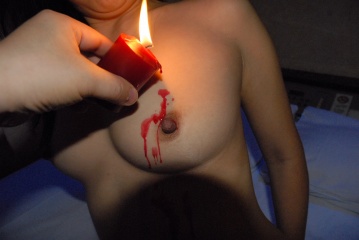
Figure 1. Wax being dripped on a nipple
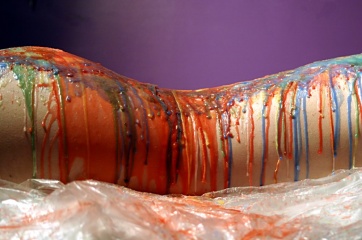
Figure 2. A woman's back after wax play
Wax play is a type of temperature play where a top or dominant holds a lit candle above a bottom or submissive and drips molten candle wax on their bare skin.
Usually the person on whom the wax is being dripped will be lying down; on their back if the wax is being dripped onto their breasts, belly, or genitals (the most common frontal targets); or on their front if the wax is being dripped on their back.
Once it has set on the skin it can easily, and often pleasurably, be scraped off. Dripping molten wax on hair, such as pubic hair, is usually not a good idea because it can be difficult to remove.
Contents
There are a number of interesting sensations and feelings involved in wax play:
- When you're blindfolded or when the wax is being dripped on your back, there can be a lot of tension or apprehension as you wait for the next drop of hot wax. How hot will it be? Will it be just a single drop or will your partner pour a stream of wax on you? Where will they let it fall?
- The sudden feeling of heat or burning can be both a sudden release from the tension, and can be a shock and quite intense.
- As the individual drops set, or as a pool of wax cools and solidifies on your skin, it can feel like tickling or as if something is crawling there.
- Feeling your partner scrape the wax off your skin with a knife or blade can be quite pleasurable depending on how they wield the knife
Wax play can be combined with bondage or mummification. To do wax play on someone who is mummified cut holes in the wrap to allow the wax to be dropped directly onto their bare skin.
Candles and wax temperature
Candles are made from paraffin, stearin, beeswax, soy, gel, or tallow. This is what allows them to burn. As well, candles commonly have additives which are used to give them different colours, different scents, or to make them more firm. Finally, paint is added to the outside of some candles to form designs.
The temperature at which any particular candle burns and, hence, the temperature of its molten wax depends on the material from which it's made. Additives---whether they are perfumes or dyes---increase or decrease this temperature. The additives which are used to make a soft candle more firm and less prone to sagging will increase the burn temperature.
If there's paint on the candle, this can---in some cases---catch fire separately to the candle itself. This can be dangerous because as you try to drip molten wax from the candle, the paint might also burn and drip, usually at a much higher temperature, with the molten wax.
Candles and allergies
Some people are allergic to some types of candle wax or to one or more of the of the additives in some candles. Before undertaking a major wax play exercise with your partner, drop a small amount of molten wax on an area of skin and check for a reaction such as irritation, itchiness, or unexpected redness.
Varying the temperature of the wax
When dripping wax on your partner, you can vary the temperature they experience by changing the height of the candle above them. The higher the candle, the further the wax has to fall through the air and the cooler it will be when it hits.
You should test the temperature of the wax on yourself before you start on your partner. Dripping some on your bare wrist first is a good idea.
Never assume that a similar looking candle, or even one out of the same box or from the same manufacturer is going to produce the same temperature wax. Candles labelled as one thing will usually have with various amounts of other chemicals, dyes, and perfumes, which each contribute to change the wax temperature. Always test each individual candle on yourself before use on your partner.
Wax will feel hotter for your partner when it is pooled on or is running down their skin. Individual drops of wax will not seem as hot.
Selecting a candle
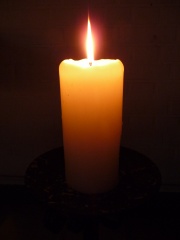
Figure 3. A good type of candle to use

Figure 4. Candles for a birthday cake. Not good choices
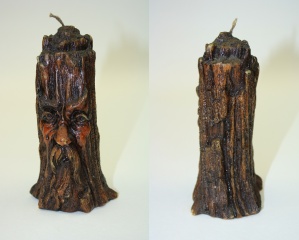
Figure 5. Front and rear view of a candle face in a tree. Also not a good choice
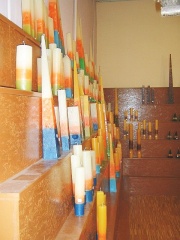
Figure 6. Decorated candles on display. Too many colours. Too many different temperatures
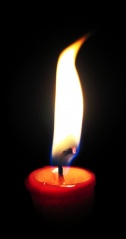
Figure 7. Close-up of a painted candle. Also not good because the paint or outer coating can catch fire and drip, while still burning, on your partner
The safest sort of candle to use for wax play is one which is the same colour all the way through and which is completely undecorated. The candle shown in figure 3 is a good example. These candle will burn at the same temperature from top to bottom.
Using candles which are decorated, or which are not the same colour all the way through are poor choices for wax play because the temperature of the wax they produces varies, often quite significantly. This makes it quite easy to accidentally burn your partner.
Figure 4 shows a type of candle which is found in many family homes. These are candles used on birthday cakes. As you can see, each candle is a different colour and will probably burn at a different temperature than the other candles. They are also quite short and thin and will not last long.
Figure 5 shows a very artistic and well-executed candle. It is completely unsuitable for wax play. Apart from messing up a pretty candle, the fact that it's shiny indicates that it is lacquered or has some other protective coating which will no doubt burn at a different temperature to the candle itself. It also appears to have a faux moss effect on the top and bits of this stuff may ignite and drop, still burning, on to your partner.
Figure 6 shows candles on display in a candle shop. Most of the candles you see here have different layers of colour. These should not be used in wax play because as the candle burns through different colour layers the resulting wax temperature will change and you may burn your partner before you realise the candle wax is now much hotter than when you started.
Figure 7 shows a close-up of the business end of a dangerous sort of candle to use in wax play. We can see that the centre of the candle is a fairly plain wax. The outside of the candle is different however. It is a paint or coating of some sort and we can see it melting separately to the wax in the centre of the candle. In fact, because the outer rim of this stuff is higher than the wax in the centre of the candle we can be sure it is melting at a significantly higher temperature than the wax. If you were to use this in wax play you would be dropping two different types of molten material on your partner---one much hotter than the other---and you could easily burn your partner with this.
Worse, wax requires a wick to burn, but these coatings can sometimes be flammable just on their own. It is possible to have burning drops of this stuff land on your partner with a rather disastrous result.
Quick selection guide
- Cheap candles tend to be very hot,
- Avoid candles which come in a wide variety of colours, which are decorated, or which have coloured or painted coatings. Plain wax candles are best,
- Some BDSM suppliers will have candles which are designed for wax play. They will be mixed to have a low wax temperature and may be shaped so that they tend not to drip wax on your hand when you're using them. Figure 1 shows one such candle in use.
Where you can drip wax
When you're deciding where to drip molten wax there are a few considerations:
- Never on the head or face. There are too many things which can go wrong here,
- Avoid bodily orifices such as the opening on the tip of the penis, the anus itself (buttocks are OK), and the vagina entrance and urethra. These areas should be off-limits because there are some very sensitive membranes there which can easily be damaged. Getting wax out of them can also be difficult,
- Be wary of hair (see below),
- Most practitioners will limit their activities to their partner's torso. However, don't neglect inner thighs because these can be quite sensual and exciting, particularly as you cautiously approach the fun bits in the middle,
- If you're wanting your partner to experience wax running over their skin you need to drip it somewhere with a slope, such as breasts. Keep in mind that if you allow the wax to pool, such as in their navel or in the small of their back, the heat will build up and there's more of a risk of burns,
- For a sexual experience nipples are always good value,
- For a sensual experience, get your partner to lie on their front and run wax along their shoulder blades.
Hair
Some of the more interesting parts of the body (both male and female) can be quite hairy. Getting wax out of hair can be very difficult. It's not dangerous to have wax in your hair, but think twice before you get it in there in the first place.
Softer wax (which melts at a lower temperature) is easier to remove than harder wax ( which usually melts at a higher temperature). You may need to cut the hair to completely remove harder wax.
Note that getting wax out of hair can be an interesting and pleasant exercise for your partner if done right.
Removing the wax from skin
Wax is fairly easy to remove from skin, more so if massage oil or similar is applied to the skin beforehand. The wax will typically just peel off, but the process of removing it can be made more sensual by using fingernails or a knife blade.
Safety
The temperature of most molten candle wax is not very hot. But cheaper candles and candles with various impurities or additives may melt at a higher temperature than you expect. Major burns are not likely (unless you set your partner on fire), but minor burns are possible. Keep cold water and appropriate medicaments handy (such as burn salve).
Candles involve flames and one risk with using them is other things catching fire, particularly when you drop a candle because wax unexpectedly drips on you. Small fire extinguishers are cheap and worth keeping around. You can usually get them at automotive supply stores. If you do manage to set fire to clothing, nylon rope, or cling wrap (such as during mummification) while it's adorning your partner, cold water will also put out the flames.
Some body parts are more sensitive to temperature than others of course. Don't expect to be able to drip the same temperature wax on genitals or nipples as you can on, say, arms or hands.
Wax running down the candle onto your hand can lead to unpleasant surprises, minor burns, or dropping the candle and setting something else (like clothing) alight.
Wax can stain clothing. Avoid wax play when you're wearing expensive clothing.
One of the most effective ways of removing candle wax from a bed sheet or from clothing is to place a paper towel on an ironing board, place the affected area of the bed sheet or clothing on the paper towel, and then place another paper towel on top, then iron the whole "sandwich" with an electric iron set to a low temperature. The iron will melt the wax and the paper towels will soak it up.
Preparation
When you're preparing for a wax play scene here are some things to do beforehand to make the play go smoothly:
- Use a painter's drop sheet or a plastic sheet to protect your play area. If you are planning on wax play in bed then putting a protective cover over the bed beforehand means you don't have to worry about drops staining your bed sheets. Similarly, a drop sheet in your dungeon means you don't end up having to scrape wax off the floor or furniture. Trying to make sure that any wax drips only on your partner, or that it doesn't run off your partner before it sets can distract you from the pleasure you should be having.
- Practise with each candle you are planning on using. Get some idea of how hot each candle burns and how high you need to hold them in advance. This will make play go much more smoothly and removes the need to test candles while your partner waits.
- Make sure you have something to light the candles with. A cigarette lighter might seem like a good idea, but sometimes they can be finicky, particularly if it's dark or your hand or fingers are wet or covered in lube. Maybe have another lit candle in a holder which you use to light the wax-dripping candles.
- Make sure you have something that can't burn like a large metal tray where you can lay your candles before and after you use them.
- Remove all flammable liquid, rags, paper, clothing, and anything else which might catch fire from your play area.
- Make sure you have some way to put out unexpected fires. A small fire extinguisher or a jug or water, or both, are good choices.